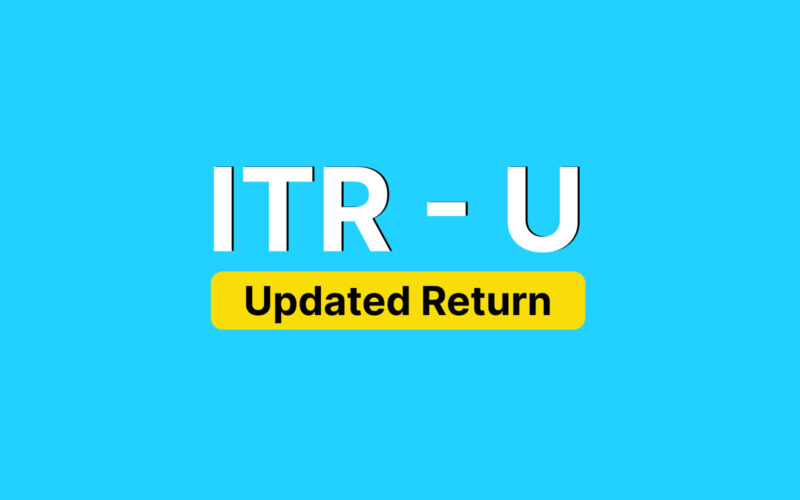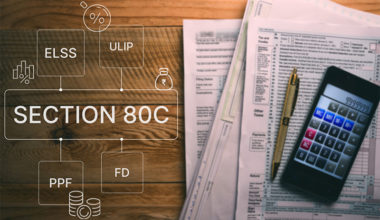Filing income tax returns (ITR) is an essential responsibility for every taxpayer. It helps individuals and entities fulfill their legal obligations and maintain transparency in their financial affairs. The Income Tax Department of India has introduced several provisions and forms to streamline the tax filing process, making it easier and more convenient for taxpayers. One such form is ITR-U, also known as the Updated Return, which allows individuals to correct any errors or omissions made while filing their original returns.
In this blog post, we will delve into the world of ITR-U, exploring what it is, when it is required, and how to file an updated return under Section 139(8A) of the Income Tax Act. Whether you have made mistakes in reporting your income, omitted certain deductions, or need to make changes to your tax details, understanding ITR-U will empower you to rectify any discrepancies and ensure compliance with the tax laws.
What is ITR U?
ITR-U refers to the Updated Return form used for filing an amended or revised income tax return in India. It is a provision provided by the Income Tax Department to enable taxpayers to correct any errors, rectify omissions, or make changes to their original tax return filing. The “U” in ITR-U stands for “Updated.”
ITR-U is primarily used when individuals or entities realize that they have made mistakes in reporting their income, claiming deductions, providing incorrect details, or omitting important information in their initial tax return. By filing an updated return using ITR-U, taxpayers can rectify these errors and ensure that their tax records reflect their financial situation accurately.
The filing of ITR-U falls under Section 139(8A) of the Income Tax Act, which allows taxpayers to revise their returns within a specific timeframe. It is important to note that ITR-U is different from the regular income tax return forms (such as ITR-1, ITR-2, etc.) used for filing the original tax return.
Filing ITR-U involves providing accurate details of the original return, specifying the changes or amendments being made, and submitting the revised return electronically through the Income Tax Department’s official website or other authorized platforms. It is crucial to ensure that the updated return is filed within the prescribed deadline to avoid penalties and legal consequences.
Who can file ITR-U?
- Return previously not filed
In the case of a Return Previously Not Filed, taxpayers can file an Updated Return to report their income and fulfill their tax obligations.
- Income not reported correctly
In situations where income was not reported correctly, taxpayers can file an Updated Return to rectify the error and provide accurate income details.
- Wrong heads of income chosen
When wrong heads of income are chosen, taxpayers can use ITR-U to correct the classification and allocate income under the appropriate heads.
- Reduction of carried forward loss
In situations involving the reduction of carried forward loss, taxpayers can file an Updated Return to adjust and reduce the carried forward loss accordingly.
- Reduction of unabsorbed depreciation
When there is a need for the reduction of unabsorbed depreciation, taxpayers can file an Updated Return to adjust and reduce the unabsorbed depreciation.
- Reduction of tax credit under Sections 115JB/115JC
In situations involving the reduction of tax credit under Sections 115JB/115JC, taxpayers can file an Updated Return to reduce the tax credit accordingly.
- Wrong rate of tax
When an incorrect rate of tax has been applied, taxpayers can use ITR-U to correct the rate and ensure accurate calculation of their tax liability.
Who Cannot File Form ITR-U?
- Return of loss
If the updated return results in a return of loss, it cannot be filed using Form ITR-U. The form is designed for rectifying errors or making changes to the original return, not for reporting a loss.
- Reduction of income tax liability
If filing an updated return reduces the income tax liability that was declared in the earlier filed return, Form ITR-U cannot be used. The purpose of the form is not to revise the tax liability to a lower amount.
- Increase in refund
If filing an updated return leads to an increase in the refund amount compared to the return filed earlier, Form ITR-U is not applicable. The form is not intended for increasing the refund amount.
- Search or requisition
If a search has been initiated under section 132 or books of accounts or any other documents have been requisitioned under section 132A, filing Form ITR-U is not allowed.
- Survey conducted
If a survey has been conducted under section 133A, Form ITR-U cannot be used for filing an updated return.
- Pending or completed proceedings
If any assessment, reassessment, re-computation, or revision proceedings are pending or have been completed for the relevant assessment year, Form ITR-U cannot be filed.
- Information under various acts
Suppose the Assessing Officer has information against the person under the Prevention of Money Laundering Act, Black Money (Undisclosed Foreign Income and Asset) and Imposition of Tax Act. In that case, Benami Property Transactions Act, or Smugglers and Foreign Exchange Manipulators Act, and the same has been communicated to the assessee, Form ITR-U is ineligible.
- Information under agreements
If information for the relevant assessment year has been received under an agreement referred to in section 90 or section 90A, and the same has been communicated to the taxpayer before the date of furnishing the return, Form ITR-U cannot be used.
- Other notified persons
There may be specific categories of individuals or entities who are notified as ineligible to file Form ITR-U as per notifications issued by the tax authorities.
How to File Form ITR-U: Step-by-Step Guide
Part A – Providing Basic Details (ITR-U)
- Fill in your PAN, Aadhaar Number, and Assessment Year for which you are filing the updated return.
- Indicate whether you have previously filed a return for this assessment year under section 139(1) or any other section or not.
- If you have filed a return before, provide details such as the form filed, acknowledgement or Receipt Number, and the date of filing the original return.
- Check your eligibility to file an updated return, ensuring you do not fall into circumstances where filing an updated return is not allowed.
- Select the appropriate ITR form for filing the updated return.
- State the reason for updating your income, such as returns previously not filed, income not reported correctly, wrong heads of income chosen, and others.
- Specify if you are filing the updated return within 12 months from the end of the relevant assessment year or between 12 to 24 months from the end of the relevant assessment year.
- Indicate if you are filing the updated return to reduce carried forward loss, unabsorbed depreciation, or tax credit.
Part B – Calculating Updated Income and Tax Liability (ITR-U)
- Mention the head of income under which you are reporting the additional income in the updated return.
- Provide the total income as per the last valid return, only if you have filed a return previously.
- Calculate the total income as per Part B-TI of the updated return.
- Determine the amount payable or refundable based on the updated return.
- Consider any amount payable or refund claimed in the last valid return.
- Account for any fee for default in furnishing the return of income under section 234F.
- Include the regular assessment tax, if applicable.
- Calculate the aggregate liability on additional income.
- Determine the additional income-tax liability on the updated income based on prescribed rates.
- Calculate the net amount payable or refundable.
- Report any tax paid under section 140B.
- Determine the tax due by subtracting the tax paid from the net amount payable.
- Provide details of tax payments made under section 140B and payments of Advance Tax/Self-Assessment Tax/Regular Assessment Tax not claimed in the earlier return.
- Note that certain credits or reliefs may not be allowed again under section 140B(2).
What is the Time Limit for Filing ITR-U?
The filing of an updated return, or ITR-U, must be done within a specific time limit. Taxpayers have a window of 24 months from the end of the relevant assessment year to file the updated return. This means that for the current financial year 2022-23, individuals can file updated returns for Assessment Year 2020-21 and Assessment Year 2021-22.
To provide a more precise understanding, here are the last dates for filing an updated ITR for specific assessment years:
| Assessment Year | Last Date of Updated ITR Filing |
| 2020-21 | 31st March 2023 |
| 2021-22 | 31st March 2024 |
| 2022-23 | 31st March 2025 |
Points to Consider for Filing ITR-U
- Review and verify information: Double-check all the information provided in the form, including personal details, PAN, Aadhaar number, and assessment year. Any errors or discrepancies could lead to complications or delays in processing the updated return.
- Eligibility criteria: Confirm that you meet the eligibility criteria for filing ITR-U. Ensure that your reason for filing for an updated return falls within the permissible circumstances, such as rectifying errors, updating income, or making changes to the original return. If you do not meet the eligibility criteria, consider using the appropriate form or seeking professional advice.
- Choose the correct ITR Form: Select the correct ITR form that corresponds to your taxpayer’s category, income sources, and updated information. Using the wrong form may lead to incorrect filings and potential penalties.
- Provide accurate reason for updating income: Clearly state the reason for updating your income in the appropriate section of the form. Whether it’s rectifying omissions, reporting income correctly, or adjusting tax liability, ensure that the reason is accurately stated to avoid any confusion.
- Timely filing: File the ITR-U within the prescribed time limit. The time limit is generally 24 months from the end of the relevant assessment year. Failing to file within the specified timeframe may result in penalties or other consequences.
- Include relevant documents: Gather and attach any supporting documents or proofs that validate the changes made in the updated return. These documents may include revised income statements, corrected deduction details, or any other relevant records.
- Check for pending proceedings: Ensure that there are no pending assessment, reassessment, re-computation, or revision proceedings for the relevant assessment year. If there are any pending proceedings, consult with a tax professional to determine the appropriate course of action.
- Tax payment details: Provide accurate information of any tax payments made under section 140B and any other payments related to advance tax, self-assessment tax, or regular assessment tax that have not been claimed in the earlier return.
- Seek professional guidance: If you are unsure about any aspect of filing ITR-U or if your situation is complex, consider seeking assistance from a qualified tax professional. They can provide guidance specific to your circumstances and help ensure compliance with tax laws.
Conclusion
Filing an updated return using ITR-U is a crucial step in rectifying errors, updating income details, and ensuring accurate tax filings. It provides taxpayers with the opportunity to correct mistakes made in the original return and comply with tax laws effectively. By understanding the concept of ITR-U and following the guidelines provided, taxpayers can navigate the process smoothly and avoid penalties or legal consequences.








